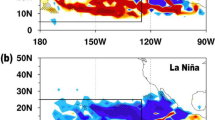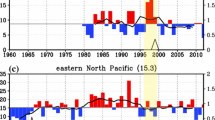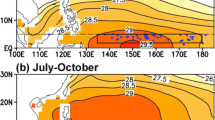Abstract
The interdecadal change of tropical cyclone (TC) controlling parameter in the western North Pacific (WNP) was investigated using observational data. Through the diagnosis of the relative role of each term of the TC genesis potential index (GPI), it was found that the dominant factor controlling interannual TC genesis frequency was specific humidity in 1950–1976, maximum potential intensity or sea surface temperature (SST) in 1977–1998, and relative vorticity in 1999–2014. The change of environmental specific humidity during 1950–1976 was primarily attributed to the advection of the mean moisture by anomalous low-level wind in ENSO developing summer. The change of SST during 1977–1998 was primarily affected by a V-shape SST pattern in western Pacific in ENSO decaying summer. The change of environment relative vorticity during 1999–2014 was primarily controlled by a strong cyclonic flow anomaly associated with CP-type El Niño. The change of dominant environmental controlling parameter is ultimately caused by the change of ENSO behavior. Compared to the first interdecadal period, a stronger EP-type ENSO variability in 1977–1998 leads to a stronger circulation and SST response in ENSO decaying phase. The occurrence of more frequent CP type El Niño in 1999–2014 was possibly attributed to both suppressed convection and low-level divergence over the central equatorial Pacific and a warming trend in the tropics.












Similar content being viewed by others

References
Cao X, Li T, Peng M et al (2014) Effects of monsoon trough interannual variation on tropical cyclogenesis over the western North Pacific. Geophys Res Lett 41(12):4332–4339
Chan J C L (1985) Tropical cyclone activity in the northwest Pacific in relation to the El Niño/Southern Oscillation phenomenon. Mon Weather Rev 113(4):599–606
Chen M, Xie P, Janowiak JE, Arkin PA (2002) Global land precipitation: a 50-yr monthly analysis based on gauge observations. J Hydrometeorol 3:249–266
Chen L, T Li, B Wang, and L Wang (2017) Formation mechanism for 2015/16 Super El Niño.Scientific Reports, 7 (2975), online. doi:10.1038/s41598-017-02926-3
Chung PH, Li T (2013) Interdecadal relationship between the mean state and El Niño types. J Clim 26(2):361–379
Emanuel K (2000) A statistical analysis of tropical cyclone intensity. Mon Weather Rev 128(4):1139–1152
Emanuel KA, Nolan DS (2004) Tropical cyclone activity and global climate. Preprints, 26th Conf. on hurricanes and tropical meteorology, Miami, FL, Am Meteorol Soc, pp 240–241
Fu B, Li T, Peng MS et al (2007) Analysis of tropical cyclogenesis in the western North Pacific for 2000 and 2001. Weather Forecast 22(4):763–780
Fu B, Peng MS, Li T et al (2012) Developing versus nondeveloping disturbances for tropical cyclone formation. Part II: western North Pacific. Mon Weather Rev 140(4):1067–1080
Gill AE (1980) Some simple solutions for heat-induced tropical circulation. Q J R Meteorol Soc 106(449):447–462
Gray WM (1968) Global view of the origin of tropical disturbances and storms. Mon Weather Rev 96(10):87
Gray WM (1979) Hurricanes: their formation, structure and likely role in the tropical circulation. Meteorol Trop Ocean 77:155–218
Ham YG, Kug JS, Park JY et al (2013) Sea surface temperature in the north tropical Atlantic as a trigger for El Niño/Southern Oscillation events. Nat Geosci 6(2):112–116
Hsu PC, Li T, Tsou CH (2011) Interactions between boreal summer intraseasonal oscillations and synoptic-scale disturbances over the western North Pacific. Part I: energetics diagnosis. J Clim 24(24):927–941
Kalnay E, Kanamitsu M, Kistler R et al (1996) The NCEP/NCAR 40-year reanalysis project. Bull Am Meteorol Soc 77(3):437–471
Knapp KR, Kruk MC, Levinson DH et al (2010) The international best track archive for climate stewardship (IBTrACS) unifying tropical cyclone data. Bull Am Meteorol Soc 91(3):363–376
Lau KH, Lau NC (1990) Observed structure and propagation characteristics of tropical summertime synoptic scale disturbances. Mon Weather Rev 118(9):1888–1913
Li T (2006) Origin of the summertime synoptic-scale wave train in the western North Pacific. J Atmos Sci 63(3):1093–1102
Li T (2012) Synoptic and climatic aspects of tropical cyclogenesis in western north pacific in cyclones: formation, triggers, and control. Oouchi K, Fudevasu H (eds). Noval Science Publishers, pp 61–94
Li T, Fu B (2006) Tropical cyclogenesis associated with Rossby wave energy dispersion of a preexisting typhoon. Part I: satellite data analyses. J Atmos Sci 63(5):1377–1389
Li T, Fu B, Ge X, et al (2003) Satellite data analysis and numerical simulation of tropical cyclone formation. Geophys Res Lett 30(21):1–4
Li Z, Yu W, Li T et al (2013) Bimodal character of cyclone climatology in the Bay of Bengal modulated by monsoon seasonal cycle. J Clim 26(3):1033–1046
Liebmann B, Hendon HH, Glick JD (1994) The relationship between tropical cyclones of the western Pacific and Indian Oceans and the Madden–Julian oscillation. J Meteorol Soc Jpn Ser II 72(3):401–412
Liu P, Kajikawa Y, Wang B et al (2009) Tropical intraseasonal variability in the MRI-20 km 60L AGCM. J Clim 22(8):2006–2022
Maloney ED, Hartmann DL (1998) Frictional moisture convergence in a composite life cycle of the Madden–Julian oscillation. J Clim 11(9):2387–2403
Mantua NJ, Hare SR, Zhang Y et al (1997) A Pacific interdecadal climate oscillation with impacts on salmon production. Bull Amer Meteor Soc 78(6):1069–1079
Mcphaden MJ, Lee T, Mcclurg D (2011) El Niño and its relationship to changing background conditions in the tropical Pacific Ocean. Geophys Res Lett 38(15):175–188
Murakami H, Li T, Peng M (2013) Changes to environmental parameters that control tropical cyclone genesis under global warming. Geophys Res Lett 40(10):2265–2270
Peng MS, Fu B, Li T et al (2011) Developing versus nondeveloping disturbances for tropical cyclone formation. Part I: North Atlantic. Mon Weather Rev 140(4):1047–1066
Rayner NA, Parker DE, Horton EB et al (2003) Global analyses of sea surface temperature, sea ice, and night marine air temperature since the late nineteenth century. J Geophys Res Atmos 108(D14):1063–1082
Sooraj KP, Kim D, Kug JS et al (2009) Effects of the low-frequency zonal wind variation on the high frequency atmospheric variability over the tropics. Clim Dyn 33(4):495–507
Tam CY, Li T (2006) The origin and dispersion characteristics of the observed tropical summertime synoptic-scale waves over the western Pacific. Mon Weather Rev 134(6):1630–1646
Wang B (1995) Interdecadal changes in El Niño onset in the last four decades. J Clim 8(2):267–285
Wang B, Chan J C L (2002) How strong ENSO events affect tropical storm activity over the western North Pacific. J Clim 15(13):1643–1658
Wang B, Wu R, Li T (2003) Atmosphere–warm ocean interaction and its impacts on Asian–Australian monsoon variation. J Clim 16(8):1195–1211
Wu MC, Chang WL, Leung WM (2004) Impacts of El Niño–Southern Oscillation events on tropical cyclone landfalling activity in the western North Pacific. J Clim 17(6):1419–1428
Wu B, Zhou T, Li T (2009) Contrast of rainfall–SST relationships in the western North Pacific between the ENSO-developing and ENSO-decaying summers. J Clim 22(16):4398–4405
Wu B, Li T, Zhou T (2010) Relative contributions of the Indian Ocean and local SST anomalies to the maintenance of the western North Pacific anomalous anticyclone during the El Niño decaying summer. J Clim 23(11):2974–2986
Xiang B, Wang B, Li T (2013) A new paradigm for predominance of standing Central Pacific Warming after the late 1990s. Clim Dyn 41(2):327–340
Xie SP, Hu K, Hafner J et al (2009) Indian Ocean capacitor effect on Indo–western Pacific climate during the summer following El Niño. J Clim 22(3):730–747
Yeh SW, Kang SK, Kirtman BP et al (2010) Decadal change in relationship between western North Pacific tropical cyclone frequency and the tropical Pacific SST. Meteorol Atmos Phys 106(3):179–189
Yu J, Li T, Tan Z et al (2015) Effects of tropical North Atlantic SST on tropical cyclone genesis in the western North Pacific. Clim Dyn 46(3–4):865–877
Acknowledgements
This work was jointly supported by China National Key R&D Program 2017YFA0603802 and 2015CB453200, NSFC Grants 41630423/41475084, NSF Grant AGS-1565653, NRL Grant N00173-16-1-G906, Jiangsu Project BK20150062 and R2014SCT001, and the Priority Academic Program Development of Jiangsu Higher Education Institutions (PAPD). This is SOEST contribution number 10253, IPRC contribution number 1291 and ESMC number 190.
Author information
Authors and Affiliations
Corresponding author
Rights and permissions
About this article
Cite this article
Hu, F., Li, T., Liu, J. et al. Cause of interdecadal change of tropical cyclone controlling parameter in the western North Pacific. Clim Dyn 51, 719–732 (2018). https://doi.org/10.1007/s00382-017-3951-z
Received:
Accepted:
Published:
Issue Date:
DOI: https://doi.org/10.1007/s00382-017-3951-z



